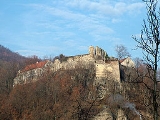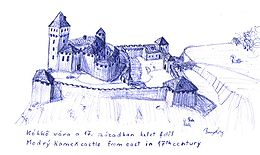
Modrý Kamen
Encyclopedia
Modrý Kameň is a town
and municipality
in the Veľký Krtíš District
of the Banská Bystrica Region
of southern Slovakia
.
and Riečka rivers. It is around 5 km from Veľký Krtíš
and 50 km from Zvolen
and is the smallest town in Slovakia.
noble family. They had to recapture the castle from sons of Casimir of the Hunt-Poznan clan by a siege in 1290. The castle was captured by Ottoman
troops in 1576, because its guard fled when they heard the approaching Ottomans. The castle was given up and subsequently destroyed by Ottoman troops in 1593. It was restored between 1609 and 1612 by Sigismund Balassa. The castle was ravaged many times during 17th century, so it became ruined and abandoned. The Balassa family built a new Baroque mansion house on the side of castle hill in early 18th century; stones of the former castle were used in the mansion building operations. The last member of the Balassa noble family died in 1899. After the demise of the Balassa family, the Almásy noble family became the proprietors of castle Modrý Kameň. They sold the demesne to the Czechoslovakia
n state in 1923.
In 1910 the settlement had 1347 mostly Slovak
inhabitants, though a significant Hungarian minority lived in Modrý Kameň (then Kékkő) too. Modrý Kameň belonged to Nógrád county
until the end of World War I
. The settlement was the center of district Modrý Kameň (Slovakian okres Modrý Kameň, Hungarian Kékkői járás) between 1912 and 1960. Electric network was built in 1943.
During World War II
, an illegal antifascist communist organization operated in the settlement. During the Slovak National Uprising
, Modrý Kameň was the center of the national revolutionary committee of the district, and partisan groups operated on the outskirts.
Modrý Kameň was pronounced a town in 1969.
 According to the 2001 census
According to the 2001 census
, the town had 1,434 inhabitants. 92.82% of inhabitants were Slovaks
, 2.79% Roma, 2.02% Hungarians and 0.35% Czechs
. The religious make-up was 79.22% Roman Catholics, 8.44% people with no religious affiliation and 7.60% Lutherans.
Town
A town is a human settlement larger than a village but smaller than a city. The size a settlement must be in order to be called a "town" varies considerably in different parts of the world, so that, for example, many American "small towns" seem to British people to be no more than villages, while...
and municipality
Municipality
A municipality is essentially an urban administrative division having corporate status and usually powers of self-government. It can also be used to mean the governing body of a municipality. A municipality is a general-purpose administrative subdivision, as opposed to a special-purpose district...
in the Veľký Krtíš District
Velký Krtíš District
Veľký Krtíš District is a district inthe Banská Bystrica Region of central Slovakia. Until 1918, the district was split between the Hungarian counties of Hont and Nógrád.-Municipalities:*Balog nad Ipľom*Bátorová*Brusník...
of the Banská Bystrica Region
Banská Bystrica Region
The Banská Bystrica Region is one of the Slovak regions in the country of Slovakia in Europe.-Geography:It is located in the central part of Slovakia and has an area of 9,455 km². The region is prevailingly mountains, with several ranges within the area. The highest of them are the Low Tatras...
of southern Slovakia
Slovakia
The Slovak Republic is a landlocked state in Central Europe. It has a population of over five million and an area of about . Slovakia is bordered by the Czech Republic and Austria to the west, Poland to the north, Ukraine to the east and Hungary to the south...
.
Geography
It is located in the Krupina Plain (Slovak: Krupinská planina) on the KrtíšKrtíš
Krtíš is a 36.5 km long river in southern central Slovakia. It flows through Zvolen and Veľký Krtíš districts, through the towns of Modrý Kameň and Veľký Krtíš. It pours to the Ipeľ river near Slovenské Ďarmoty as a right tributary....
and Riečka rivers. It is around 5 km from Veľký Krtíš
Velký Krtíš
Veľký Krtíš is a town in southern Slovakia, situated in the historical Novohrad region. The town's most important economic sectors are mining and agriculture.-History:...
and 50 km from Zvolen
Zvolen
Zvolen |Slatina]] rivers, close to Banská Bystrica. With its ancient castle, the town has a historical center, which represents the seat of an okres .-History:...
and is the smallest town in Slovakia.
History
The name of the town was first mentioned as Keykkw (Hungarian: Kékkő) in 1290. The name of the settlement means "Blue rock". Ruins of the castle Modrý Kameň stand on a rock pinnacle above the town. The castle was built in second half of 13th century by the ancestors of the BalassaBalassa
Balassa is a Hungarian surname and may refer to:* Bálint Balassa, Hungarian poet * Balint Balassi Memorial Sword Award, Hungarian literary award* Béla Balassa, Hungarian economist who gave his name to the Balassa-Samuelson effect...
noble family. They had to recapture the castle from sons of Casimir of the Hunt-Poznan clan by a siege in 1290. The castle was captured by Ottoman
Ottoman Empire
The Ottoman EmpireIt was usually referred to as the "Ottoman Empire", the "Turkish Empire", the "Ottoman Caliphate" or more commonly "Turkey" by its contemporaries...
troops in 1576, because its guard fled when they heard the approaching Ottomans. The castle was given up and subsequently destroyed by Ottoman troops in 1593. It was restored between 1609 and 1612 by Sigismund Balassa. The castle was ravaged many times during 17th century, so it became ruined and abandoned. The Balassa family built a new Baroque mansion house on the side of castle hill in early 18th century; stones of the former castle were used in the mansion building operations. The last member of the Balassa noble family died in 1899. After the demise of the Balassa family, the Almásy noble family became the proprietors of castle Modrý Kameň. They sold the demesne to the Czechoslovakia
Czechoslovakia
Czechoslovakia or Czecho-Slovakia was a sovereign state in Central Europe which existed from October 1918, when it declared its independence from the Austro-Hungarian Empire, until 1992...
n state in 1923.
In 1910 the settlement had 1347 mostly Slovak
Slovaks
The Slovaks, Slovak people, or Slovakians are a West Slavic people that primarily inhabit Slovakia and speak the Slovak language, which is closely related to the Czech language.Most Slovaks today live within the borders of the independent Slovakia...
inhabitants, though a significant Hungarian minority lived in Modrý Kameň (then Kékkő) too. Modrý Kameň belonged to Nógrád county
Nógrád
Nógrád is a village in Nógrád County, Hungary.- External links :*...
until the end of World War I
World War I
World War I , which was predominantly called the World War or the Great War from its occurrence until 1939, and the First World War or World War I thereafter, was a major war centred in Europe that began on 28 July 1914 and lasted until 11 November 1918...
. The settlement was the center of district Modrý Kameň (Slovakian okres Modrý Kameň, Hungarian Kékkői járás) between 1912 and 1960. Electric network was built in 1943.
During World War II
World War II
World War II, or the Second World War , was a global conflict lasting from 1939 to 1945, involving most of the world's nations—including all of the great powers—eventually forming two opposing military alliances: the Allies and the Axis...
, an illegal antifascist communist organization operated in the settlement. During the Slovak National Uprising
Slovak National Uprising
The Slovak National Uprising or 1944 Uprising was an armed insurrection organized by the Slovak resistance movement during World War II. It was launched on August 29 1944 from Banská Bystrica in an attempt to overthrow the collaborationist Slovak State of Jozef Tiso...
, Modrý Kameň was the center of the national revolutionary committee of the district, and partisan groups operated on the outskirts.
Modrý Kameň was pronounced a town in 1969.
Sights
- Roman Catholic church was built in 1879
- Calvary was founded in the beginning of 18th century, its chapel was built in 1859
- Modrý Kameň Castle Museum (Marionette and toy museum, Valentine BalassiBálint BalassiBálint Balassi baron of Kékkő and Gyarmat, , was a multilingual Hungarian Renaissance lyric poet, who wrote mostly in Hungarian...
poet’s life and work, Ethnographic exhibition of the region, A look at the history of dental technology and stomatology)
Demographics

Census
A census is the procedure of systematically acquiring and recording information about the members of a given population. It is a regularly occurring and official count of a particular population. The term is used mostly in connection with national population and housing censuses; other common...
, the town had 1,434 inhabitants. 92.82% of inhabitants were Slovaks
Slovaks
The Slovaks, Slovak people, or Slovakians are a West Slavic people that primarily inhabit Slovakia and speak the Slovak language, which is closely related to the Czech language.Most Slovaks today live within the borders of the independent Slovakia...
, 2.79% Roma, 2.02% Hungarians and 0.35% Czechs
Czech people
Czechs, or Czech people are a western Slavic people of Central Europe, living predominantly in the Czech Republic. Small populations of Czechs also live in Slovakia, Austria, the United States, the United Kingdom, Chile, Argentina, Canada, Germany, Russia and other countries...
. The religious make-up was 79.22% Roman Catholics, 8.44% people with no religious affiliation and 7.60% Lutherans.

